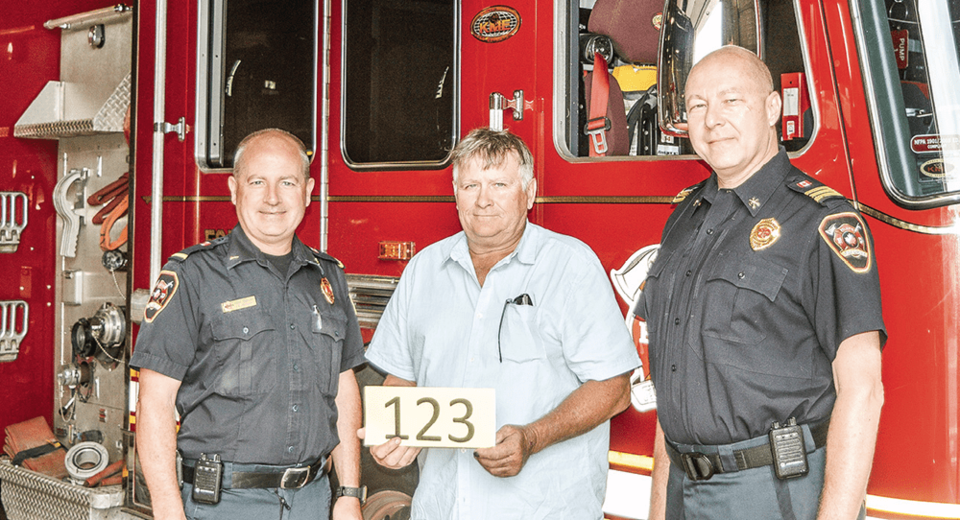BY GLORIA J. KATCH Special to the VOICE
“You can’t put a price on saving lives,” said Henry Swierenga, a Member Service Representative of Zone 5 of the Ontario Federation of Agriculture (OFA), in reference to the cost of the new $100 signs marking rural locations. Swierenga, a delegate at last month’s Pelham Town Council meeting, was there to promote farm safety and awareness of the 9-1-1 signs, and the initiative received council’s unanimous approval.
Pelham is the first municipality in Niagara to adopt the rural signage program, known as The Emily Project, and Mayor Marvin Junkin officially became its first applicant.
Sign applications are available at Fire Station #1, on Highway 20, noted Pelham Fire Chief Bob Lymburner. Previously, if there wasn’t a house on an agricultural plot of land, then an address couldn’t be assigned to that area, leaving it dangerously problematic for emergency rescue teams to find anyone injured in a rural accident.
The Emily Project stemmed from the OFA following the 2014 death of seven-year-old Emily Trudeau, the result of a fall from a tractor in Northcumberland County, Ontario. When paramedics were finally called, her father could see them pass their field and go to an adjacent area because there was no signage or markers to find them in time. Scott Trudeau, Emily’s father, decided shortly after to create this 9-1-1 endeavour, which was implemented in North Cumberland three years later.
 While a child falling from a tractor would seem like a rare occurrence, the Canadian Agricultural Surveillance Program reported that between 1990 and 2003, 274 children and youths under 19 years were killed in farm accidents, and a half of these were due to machine rollovers and runovers. An additional 4,716 children spent at least one day in a hospital due to an agricultural injury, again with half of them being machine-related.
While a child falling from a tractor would seem like a rare occurrence, the Canadian Agricultural Surveillance Program reported that between 1990 and 2003, 274 children and youths under 19 years were killed in farm accidents, and a half of these were due to machine rollovers and runovers. An additional 4,716 children spent at least one day in a hospital due to an agricultural injury, again with half of them being machine-related.
However, the good news is five years later the program is now officially launched and has reached Niagara. Swierenga pointed out that it takes time to “work through the bureaucracy.”
“Anything we can do to build in another safety layer in there, especially for EMS to respond, is important,” said Swierenga, who works with four OFA regions, including Niagara, and is moving ahead full-throttle in promoting this project to all municipalities in Ontario. Wainfleet has embraced it, and he believes many municipalities are “looking at it very seriously.” He doesn’t believe there would be any opposition to the scheme.
According to the Farm Safety Centre in Alberta, farming ranks as the third most “hazardous industry” in Canada. Canadian Agricultural Injury Reporting (CAIR) has conducted longitudinal studies monitoring farm safety and fatalities and reports from 1990 through 2008, 1,975 agriculture deaths were recorded in Canada. The Canadian Agricultural Safety Program also reports an average of 114 people killed and another 1,499 seriously injured in 2010. While all agriculture and health and safety organizations agree farming is a dangerous business, statistics vary and officials believe that accidents are under-reported, as accidents victims showing up emergency rooms may not be documented as farm-related.
In reference to the reoccurring patterns of injury due to machinery, Hacault from CAIR states, “If more producers made sure all their tractors had Roll Over Protection Systems (ROPS) and wore seatbelts, it would go a long way toward making farm work safer.”
“Farmers are working with big machines and in very isolated fields,” Swarienga noted. Even in areas where there is a home on the property, it’s difficult when the home is also a workplace, and parents have to be concerned about where the children are playing and interacting.
Murray Bering, Director of the Niagara South Board of the OFA, and owner of White Meadows Farms, on Effingham Street in Pelham, said he produces maple syrup on three different woodlots, totalling 130 acres. He has a laneway going into the fields, but if an accident were to happen, paramedics would respond by going into the building, while in fact he could be “a half mile down the road.” Bering is also a former volunteer firefighter for Station # 3 in Pelham, and recalled incidents in which locating accident victims was difficult.
As the agriculture business has expanded, there are many more large plots of vacant land, and many people hired to tend the crops don’t often know where they are, said Bering. Even for something as simple as receiving deliveries of products shipped, the signage would make it easier for suppliers to drop off goods in the right location.
Bering is surprised that the emergency signage wasn’t made mandatory or compulsory for rural areas.
While Fire Chief Lymburner said he doesn’t “know exactly” the number of rural accidents he has had to respond to, he said it was “a fair amount.” Even if a car accident occurs at the side of a road by a large stretch of farmland, the occupants could see the numbered signage, which would allow emergency units to be able to respond faster. This is particularly useful for long roads, which span the entire town, or like Effingham that navigates through two jurisdictions from Pelham into St. Catharines, explained Lymburner.
The 9-1-1 Rural signs will be yellow and black with a number, to be assigned by the Town’s Planning Department. When someone calls to report an incident near that sign number, it will automatically alert computer aided dispatch that it is a rural location. The signs will be posted at entranceways of every 100-acre parcel of land. The Town is encouraging farmers to submit an application at the fire station for a sign. The fee of $100 includes installation, said Lymburner, adding the process “from start to finish should take about three to four weeks.”
Lymburner is expecting about 30 to 40 applications in the first year, many of them from large landowners along the river banks in Pelham. However, while the applications were ready for processing about two weeks ago, no one had filled out the first application, as yet, aside from Mayor Junkin. As a part of promoting the Emily Project, he said he wants to take a picture of the person receiving the first sign on their property.
“It’s hard to visualize, unless you see it,” he said.
Asked if the Mayor would be a suitable candidate as the first applicant, Lymburner replied, “Well that would be a double whammy. Marv is a good example. His property fronts two roads, and he has a cross culvert with an entranceway where the sign could be put.”
Asked about his experience with farm accidents, the Mayor waved his hand noting it was “nothing serious,” but a lengthy scar from his wrist to his thumb, and a missing finger tip, suggested otherwise. The result of an encounter with a power takeoff shaft, Junkin said that such devices need safety guards, otherwise a person can get their limbs and clothing caught in the equipment.
“If everyone would keep all shields in place, it’s a lot safer for everyone.”
In reference to the Emily Project, Mayor Junkin said he had heard about the circumstances of the event when it happened, and that there would be “momentum building” to act on it.
“Farming and mining are the two most dangerous occupations,” he said.
As far as children being involved in accidents, Junkin said a few years back he heard of a man who was backing his hay wagon into the barn that only had so much clearance, and forgot his children were on top, knocking them over.
Lymburner and Junkin traded accounts of other accidents they had heard about.
With education and awareness there has been some improvement. Fatalities in 2015 dropped to 43 in Canada. While CASA and other safety organizations recommend rollover protection mechanisms on large tractors and seatbelts, Junkin said enclosed tractor cabs are designed to protect during a rollover. However, he admits many farmers don’t use the seatbelts on their tractors, because some of the older models don’t have them, and, frankly, many farmers don’t like to use them, himself included. “The only way to improve safety is through legislation, and it would be incumbent upon the province to do that,” he said.
For those who are wanting to beef up their farm safety plan, please visit: www.casa-acsa.ca/en/canadian-agricultural-safety-association.
In the meantime, the new 9-1-1 Rural signs complement the other emergency signs, and both Junkin and Lymburner are pleased.
“Even if only six farmers do it, it saves us worrying about six less locations. Even if it saves one life, then it’s worth it.” said Lymburner.



